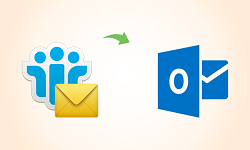How to Open NSF Files In Outlook – Access .nsf File with Outlook


“Hello, all! I am facing one or another hurdle while opening NSF files in Microsoft Outlook. Several important mailboxes of the source file need to be viewed but, I am unable to discover the complete information in target email client. I have tried numerous tricks, facing one or the different challenge but, I am getting no worthy solution. Now, I want help from you guys! Can anyone here please help me out with a solution on how to read Lotus Notes NSF files in Outlook email client?”
When there is a choice between IBM Notes and Microsoft Outlook, enterprises usually prefer Outlook for their purpose. In fact, in today’s date, users are observed shifting their data from Lotus Notes to Outlook application. In this post, we are going to illustrate the challenges behind how to access .nsf file with Outlook 2010, 2013, 2016 and solution to do the same.
Challenge Behind Reading Lotus Notes NSF Files in Outlook
The primary issue involved with this type of migration is variation in the database file formats. Both sources, as well as destination platforms, are having different formats. Well, it might be known to you that all email clients utilize some type of data file where mailbox content like contact, emails, journals, etc., are stored. In Microsoft Outlook, OST and PST files are used for storing such type of contents and in IBM Notes, NSF files are used to save its respective mailboxes. The fact clearly tells us that NSF to PST file conversion is required to access the mailbox data.
How to Read Lotus Notes NSF Files in Outlook
The method involves two major tasks to be carried away, which are mentioned below:
- Export NSF emails
- Import into Outlook
Following is the description of both these methods that will help you to access and open NSF file in Outlook 2016, 2013, 2010, 2007.
Export Lotus Notes NSF Emails
- Close all running apps of your PC and open Lotus Notes email client.
- Select the email from source mailing application, which you desire to open in Microsoft Outlook.
- Click on File >> Export to open a dialog box in front of you.
- In the current window, mention the file name and under Save Type As section, choose Structured Text from the list. Now select the location of your PC where exported email file is to be saved.
- Click on Export button and then, complete the details given on the current dialog box.
- When you are done with filling of required data, click on OK button to initiate the process of opening NSF files in Outlook 2010, 2013, 2016.
- Repeat Step (2) to (6) for all IBM Notes emails, which are to be read in Outlook client.
When the exported content gets saved at the defined location, convert it into CSV file format. The reason behind converting the file is that Microsoft Outlook does not support ‘Structured Text’ file. This means you need to convert exported NSF email files into CSV format. Now save the Structured Text file in .csv extension and then, proceed with a second major step.
Import CSV File in MS Outlook
- Close all the running applications from your PC and open MS Outlook.
- Click on File >> Open >> Import for launching the Import and Export Wizard.
- Choose Import from another program or file option and click Next.
- A list of file options appears in which you have to choose Comma Separated Values (Windows) option.
- Click on the Browse button to select the exported NSF email file from your system.
- Proceed with further steps to completely import the Lotus Notes exported file into MS Outlook
Conclusion With A Tip of Expert’s Advice
In this post, the solution for how to read Lotus Notes NSF files in Outlook 2016, 2013, 2010 is provided when IBM Notes app is present on your system, and only a few numbers of emails are to be opened in Outlook program. Unfortunately, there is no other solution rather than opting for NSF to PST file converters, which are third party software.
These software are purposely programmed to export bulk-sized NSF file to PST format. The conversion involves complete mailbox contents, including emails, names.nsf, calendar, etc. Interested users can search for these type of product on the web to choose any one of them. This approach will not only support bulk data conversion but, also maintain data integrity throughout the procedure.